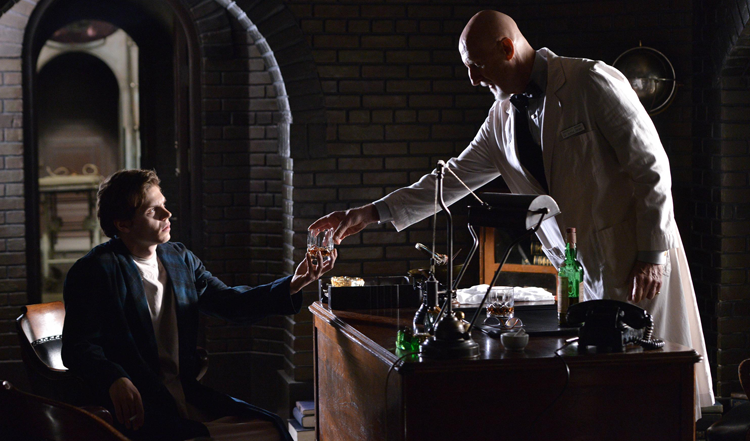DarkMedia Interviews Dr. Elizabeth Miller:
Elizabeth Miller is recognized internationally for her expertise on Bram Stoker’s 1897 novel Dracula – its origins in folklore, literature and history, as well as its influence on the culture of the twentieth and twenty-first centuries.
She has lectured on the subject throughout Canada (including presentations for the Royal Winnipeg Ballet, the Stratford Festival and CBC-TV’s “Opening Night”), as well as in the United States, England, Ireland, Germany, Poland and Romania.
In addition to participating in several television documentaries on both sides of the Atlantic, Dr. Miller has been interviewed by major media including the BBC, ABC (“20/20”), CBC, the Guardian, U.S. News & World Report, the New York Times, the Chicago Tribune, Entertainment Weekly, the Globe & Mail, the Los Angeles Times, and the Wall Street Journal.
Her publications on Dracula include dozens of articles and several books: Reflections on Dracula (1997), Dracula: The Shade and the Shadow (1998), Dracula: Sense & Nonsense (2000; rev 2006), A Dracula Handbook (2005), and Bram Stoker’s Dracula: A Documentary Journey into Vampire Country and the Dracula Phenomenon (2009). [http://www.ucs.mun.ca/~emiller/elizabeth_miller.html]
What was your first experience with Bram Stoker’s “Dracula”? And what inspired you to become an expert on the text? At this point, how many times would you say you’ve read it?
While I used to watch an occasional Dracula movie many years ago (including Lugosi and Lee), I was not a great fan. My serious interest in this subject is relatively new (since the early 1990s). I had been teaching a university course on the British Romantic poets (Byron and Shelley) and became drawn to Frankenstein. Then I decided to explore the lesser known writer of that group, Byron’s physician John Polidori who wrote the first piece of vampire fiction in English Literature (“The Vampyre”). I traced the literary vampire through the 19th century, culminating in Dracula. I was hooked! From that point on, I included Dracula both in a course on 19th-century Gothic Fiction and a first-year Introduction to the Novel.
I have been doing serious study of the Dracula phenomenon for several years, during which time I have lectured on it at many venues both in North America and Europe, including the World Dracula Congress (Romania), the National Library of Ireland (Dublin) and the International Conference on the Fantastic in the Arts (Ft Lauderdale FL). I have published several books on the subject. Even though I am now retired (living in Toronto), I still give frequent guest lectures.
How many times have I read Dracula? That’s difficult to say. Sometimes I re-read specific sections in relation to some research I am doing. But I’d estimate I have read it (cover to cover) about half a dozen times.
What do you think of the various interpretations and adaptations of Dracula? Do you have a favorite?
Let’s begin with the novel. The interpretation that I believe Bram Stoker had in mind was that the novel plays out the ancient struggle between good and evil. But on closer examination, the book yields a variety of alternative themes, ranging from psychosexual to feminist. For me, I see the novel (whether its author intended or not) as providing insight into the fears, anxieties and desires of late-Victorian England – about evolution, atavism, blurring of gender boundaries, foreign immigration, etc.
The numerous adaptations of Dracula, from stage to film, from musicals to ballets, demonstrate its staying power. As far as film adaptations go, I do like Nosferatu (1922) and its remake (1979). As for the film that adheres the closest to Stoker’s text, it’s Count Dracula with Louis Jourdan (1978). But my favorite adaptation is a production created and first performed in 1998 by Canada’s Royal Winnipeg Ballet. (It was later adapted into film as Dracula: Pages from a Virgin’s Diary).
Which modern vision of the vampire do you think is most in keeping with the mythology Bram Stoker brought to life?
Stoker’s vampire was drawn to a great extent from folklore. In the novel, the Count is not at all attractive. He has bushy eyebrows, long-pointed fingernails, hairy palms, and bad breath. He is, after all, a walking corpse! Most of today’s vampires have moved a considerable distance from the original. But occasionally a writer will restore the fanged monster of Stoker’s novel (Stephen King and Guillermo del Toro, for example).
Stoker’s Dracula is the embodiment of evil. Even his name was selected by because Stoker read that it was a Romanian word for “the devil”.Do you think Dracula is a sympathetic character?
Not in the novel. Stoker’s Dracula is the embodiment of evil. Even his name was selected by because Stoker read that it was a Romanian word for “the devil”. Consistently throughout the book, the Count acts without remorse. Even though he is probably the most interesting character in the book, he is not presented in a sympathetic light. As the 20th century progressed, however, vampires – including Dracula – began to be presented as more complex individuals, at times sympathetic and even admirable.
How important would you say the setting is to the story? Historical context aside, did it require a place like Transylvania, or could it have happened anywhere?
I would say that setting is crucial. Stoker’s vampire came not only from “away” but from a distant, remote, mysterious place. That makes him different, foreign, something to be feared and repelled – the “Other”. By the way, Stoker was originally going to have his vampire come from Styria (a region of Austria) but changed it to Transylvania having read an article about Transylvanian superstitions (including belief in vampires).
How would you categorize the novel? Horror? Gothic fiction? How does it exemplify or transcend these kinds of labels?
It is a horror novel – the stuff of nightmares. It still has the power to frighten. I’ve had students tell me they couldn’t read it at night. The horror is not as graphic as some modern readers would like, but it is visceral. Dracula also has many of the trappings of the traditional British Gothic novel: villain, maiden in distress and hero; dark aristocratic seducer; castles with creaking doors; gloomy, forbidding landscapes.
What book to you like to give as a gift, and why?
It is a horror novel – the stuff of nightmares. It still has the power to frighten. I’ve had students tell me they couldn’t read it at night.This depends on whom I am giving it to. If a person is interested in vampire literature and has read only Dracula, I’d have to pick between Salem’s Lot (King) and I Am Legend (Matheson). If the person wants something more contemporary that still retains the horror of the original, I’d select The Strain (del Toro & Hogan).
What are you reading right now?
I prefer non-fiction to fiction. I just finished reading Carol Senf’s new book, Bram Stoker. It’s a study of Gothic elements not only in Dracula but in the entire body of Stoker’s writing (he published 18 books and dozens of short stories).
From Dracula to Twilight, what do you think of the evolution of the vampire in mythology and literature? Why do you think the image has changed so drastically since 1897? Do you credit anyone, specifically for perpetuating this change?
I suppose it is to the credit of Stoker and his novel that the vampire as a literary (and cinematic) trope has survived for so long. The vampire is, after all, a shape-shifter! Its ability to adapt has saved it from an ignominious coffin. But the change may have come at a cost – the loss of much of the power, grandeur and intensity that is part of the archetype. Is there a point at which the vampire will be permanently defanged, with nothing left but the sparkle?
Modern society is insatiable for material and media on the subject of vampires. Was it this way when Bram Stoker first published Dracula? How well was it received at the time?
When Dracula was first published in 1897, sales were moderate. It did receive quite a few reviews, most of them positive, and just about all of them seeing it as a horror story and nothing more. It was certainly not a bestseller and did not bring Stoker fame during his lifetime.
What are you currently working on? You’ve mentioned that next year, 2012 is the centenary of Bram Stoker’s death. Can you give us a preview of what to expect?
The focus right now is on 2012. I am working with Dacre Stoker (Bram’s great-grandnephew) on several projects (including a book), all involving the emergence of new family-owned material that provides further illumination of Stoker’s life and work. We have already been invited to present our findings, as a sort of tribute to Bram Stoker, at the National Library of Ireland in Dublin. Conferences are being planned for Trinity College (Stoker’s alma mater) and the University of Hull. More activities are in the works. I will be posting regular updates on my blog.
What do you think of the vampire? Monster or hero? Is it ever really that simple?
For me, the vampire is a monster. It’s that simple!
Finally, what’s got you excited or inspired?
Right now – the prospect of 2012.
Dr. Elizabeth Miller can be found on her website: www.blooferland.com
She is also the author of the following books:
Dracula: Sense & Nonsense (2004)
A Dracula Handbook (2005)
Bram Stoker’s Notes for Dracula (2008)
Bram Stoker’s Dracula: A Documentary Journey (2009)
(All interviews are the exclusive property of DarkMedia, and may not be reproduced or shared without permission, excepting the posting of links.)





![West Forest [Short Fiction]](https://darkmediaonline.com/wp-content/uploads/2013/01/black-and-white-forest-wallpaper.jpg)











4 Comments